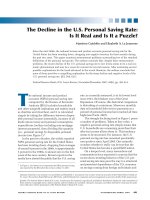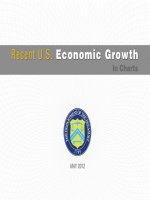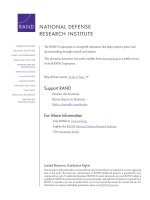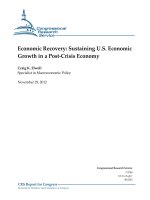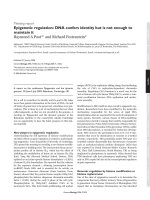U s job growth eases, but is too strong to suit investors the new york times
Bạn đang xem bản rút gọn của tài liệu. Xem và tải ngay bản đầy đủ của tài liệu tại đây (332.46 KB, 6 trang )
10/8/22, 5:25 AM
U.S. Job Growth Eases, but Is Too Strong to Suit Investors - The New York Times
/>
U.S. Job Growth Eases, but Is Too Strong to Suit Investors
The gain of 263,000 was shy of recent monthly totals but still robust. Stocks fell on fears
of a harder, longer Fed campaign to fight inflation.
Monthly change in jobs
+600,000 jobs
+263,000
in September
+400,000
+200,000
Sept. ’21
Dec.
March ’22
June
Sept.
Data is seasonally adjusted. • Source: Bureau of Labor Statistics • By Ella Koeze
By Sydney Ember
Oct. 7, 2022
Updated 5:24 p.m. ET
Job growth eased slightly in September but remained robust, indicating that the economy
was maintaining momentum despite higher interest rates. But the strong showing left
many investors unhappy because they saw signs that the fight against inflation may
become tougher and more prolonged.
Employers added 263,000 jobs on a seasonally adjusted basis, the Labor Department said
Friday, a decline from 315,000 in August. The number was the lowest since April 2021 but
still strong by prepandemic standards. The unemployment rate fell to 3.5 percent,
equaling a five-decade low.
“If I had just woken up from a really long nap and seen these numbers, I would conclude
that we still have one of the strongest job markets that we’ve ever enjoyed,” said Carl
Tannenbaum, chief economist at Northern Trust.
/>
1/6
10/8/22, 5:25 AM
U.S. Job Growth Eases, but Is Too Strong to Suit Investors - The New York Times
Officials at the Federal Reserve have been keeping a close eye on hiring and wages as
they proceed with a series of rate increases meant to combat inflation. The job data
indicates that, for now, they are doing so without tipping the economy into a recession
that would throw millions out of work.
But it also increases the prospect that the effort to subdue price increases will be more
prolonged. For investors, that came as bad news, since higher interest rates raise costs
for companies and weigh on stock prices.
The S&P 500 recorded its worst one-day performance since mid-September, falling 2.8
percent and eroding gains from earlier in the week.
Fed officials have signaled in speeches this week that they remain resolute in trying to
wrestle inflation lower, and that they are waiting for clear evidence that the economy is
headed back toward price stability before they pull back.
Wage growth has subsided somewhat, at least compared with the trend a year ago.
Average hourly earnings climbed 5 percent from a year earlier, roughly matching
economists’ expectations but slowing down slightly from the prior annual reading.
Wages are still growing, but less rapidly in some sectors
Percent change in earnings for nonmanagers since January 2019 by sector
+25%
Leisure and hospitality
Education and health
+20
+15
All industries
+10
+5
2019
+25%
2020
2021
2022
2019
Retail
2020
2021
2022
Business services
+20
+15
+10
+5
/>
2/6
10/8/22, 5:25 AM
U.S. Job Growth Eases, but Is Too Strong to Suit Investors - The New York Times
2019
+25%
2020
2021
2022
2019
Construction
2020
2021
2022
Manufacturing
+20
+15
+10
+5
2019
2020
2021
2022
2019
2020
2021
2022
Data is seasonally adjusted. • Source: Bureau of Labor Statistics • By Ella Koeze
Although the rise in wages is not keeping up with inflation, it has remained fast enough
that Fed officials see it as a sign that they will need to take further steps to cool off the
economy, since employers are likely to continue raising prices to cover increasing labor
costs.
Beyond the central bank, the report had political repercussions. With the midterm
elections just weeks away, both parties seized on the data to make the case that they are
the best stewards of the economy.
In a speech before factory workers at a Volvo plant in Hagerstown, Md., President Biden
said the numbers were a sign that the economy was making a transition to stable growth.
“Our job market continues to show resilience as we navigate through this economic
transition,” he said. “The pace of job growth is cooling while still powering our recovery
forward.”
Republicans, in turn, pounced on indications that the job market was cooling to assail Mr.
Biden for economic mismanagement.
“The economy is shrinking, inflation is raging, and job growth is slowing,” said
Representative Kevin Brady of Texas, the top Republican on the House Ways and Means
Committee.
Beyond the partisan spin, it appears that after months of vigorous hiring that defied
economists’ expectations, the high-flying labor market is coming back down to earth.
There were some notable bright spots in the September report. Health care employers
and leisure and hospitality businesses, which were both battered by the pandemic,
continued to add jobs. Construction did likewise, despite a slowdown in the housing
market.
/>
3/6
10/8/22, 5:25 AM
U.S. Job Growth Eases, but Is Too Strong to Suit Investors - The New York Times
But deeper cracks have started to show in other industries, as consumers pull back on
spending in the face of financial instability. Hiring in the retail industry was basically flat,
and jobs in trucking — a pandemic winner — dropped by more than 11,000.
In a move broadly consistent with this pullback, Amazon recently announced a slowdown
in hiring, and said this week that it planned to hire 150,000 workers this holiday season,
on a par with last year.
There are other signs that the gap is narrowing between the supply of labor and the
demand. The number of job openings decreased in August to 10.1 million, from 11.2 million
in July. Filings for unemployment benefits last week rose modestly.
From the Fed’s perspective, “we’ve had some incremental positive developments in the
labor market — job openings are declining, wage growth seems to be slowing a little bit,
at the margin,” said Aneta Markowska, chief financial economist at the investment bank
Jefferies. “It’s a baby step in the right direction.”
Share of people who are in the labor force (employed, unemployed but looking for work or
on temporary layoff)
63%
62.3%
62
61
2019
2020
2021
2022
Data is seasonally adjusted. • Source: Bureau of Labor Statistics • By Ella Koeze
The labor force participation rate — a measure of how many people are working or
actively looking for jobs — ticked down slightly in September, to 62.3 percent, from 62.4
percent in August, though it was in line with the level it has hovered around for most of
2022.
A less frenzied job market has been welcome relief for employers after months of intense
competition for labor drove wages up precipitously and left many businesses grumbling
that they could not fill open positions.
/>
4/6
10/8/22, 5:25 AM
U.S. Job Growth Eases, but Is Too Strong to Suit Investors - The New York Times
Vision Hospitality Group, a hotel ownership and management company based in
Chattanooga, Tenn., has struggled to hire workers despite raising wages 30 percent since
2019 and offering incentives like daily pay for employees, said Mitch Patel, the company’s
founder and chief executive.
To compensate for the persistent labor shortage, the company, which has about 1,500
employees, has relied more on temporary contract workers than it had in the past. It has
also learned how to operate more efficiently, allowing guests to check in on their mobile
phones, for instance, and providing housekeeping by request.
But Mr. Patel said he had noticed that hiring had gotten a little easier more recently, and
that turnover was lower. Rather than operating at 70 percent of full staffing, he said, the
company is at more like 90 percent.
“It’s still challenging but it is getting better,” he said.
Yet what may be good for the economy writ large will inevitably hurt some workers,
particularly those in low-wage jobs, who have been able to leverage the extraordinarily
tight labor market in the pandemic era to demand higher pay, better benefits and more
flexible schedules. Even if the economy avoids a recession, workers could still see their
advantage — and their standard of living — slip away.
“A slowdown could feel uncomfortable for some people,” said Julia Pollak, chief
economist at ZipRecruiter. “If things go back to normal, that will be pretty gloomy for
them. But it doesn’t mean that we’re in a recession — it just means we’re back in that
normal labor market environment where job seeking is difficult.”
Still, some economists are forecasting that the economic slowdown will become more
pronounced in the coming months. The possibility of job losses looms large.
“Going forward, we definitely expect a more significant moderation in hiring,” said
Nancy Vanden Houten, an economist at Oxford Economics. “We think that corporate
profits are going to weaken quite a bit as the economy slows, and that will lead to some
pullback in hiring and ultimately some layoffs.”
Already, some companies are tempering their hiring ambitions.
Jeff Ohlemacher, the owner and chief executive of EMC Precision, which manufactures
precision machined parts such as shafts for blenders and shock absorbers for
amusement park rides, said he had increased his company’s head count this year to 143
from 105 because demand from customers was so strong.
“Up until recently we pretty much, if somebody had a high score on a mechanical
aptitude test and it was a good cultural fit, we would hire them,” said Mr. Ohlemacher,
whose company has plants in Elyria, Ohio, and Sheridan, Ind.
/>
5/6
10/8/22, 5:25 AM
U.S. Job Growth Eases, but Is Too Strong to Suit Investors - The New York Times
But while business conditions are still “extremely good,” he said he was not looking to
expand the company further at this point, estimating that he would bring on only 10
employees for the remainder of the year, to account for attrition and any new business.
“We think right now we’re at full employment,” he said. “And with the slowing of growth
that we’ve seen, we think we’re about right-sized.”
Reporting was contributed by Jeanna Smialek, Alan Rappeport, Joe Rennison and Lydia DePillis.
Sydney Ember is an economics reporter. Previously, she covered Bernie Sanders's presidential campaign and the
2020 election, including living in Iowa for three months during the run-up to the state's caucuses.
@melbournecoal
/>
6/6

